With all the time spent monitoring the pulses of spring songbird migration, sometimes it just takes one bird to perch in just the right place, at just the right time, in the light of the morning sun to provide an exciting series of photos. A beautiful female Orchard Oriole did just that last week while I monitored migrant songbirds, camera in hand at Melody’s Grove, just 200 yards from home. Orchard Orioles had been active for a few days, especially males. But that morning, it was clear there was an influx of a few females, and I had a couple of my usual hit or miss quick photo opportunities as the orioles fed among fresh yellow blossoms.
Initially I had a chance to photograph one female Orchard Oriole a couple times, but she was quite wary, even though I was hidden in my mobile blind (my van) and didn’t move or make any noise. Then too, when I did have a chance to photograph the first female, she tended to stay behind vegetation, peering around periodically with her head just above the leaves. I had similar short interactions with male Orchards too. Oh well, these bouts always provide a little boost of adrenaline with the hope of getting a quality photo. That’s normal for bird photography, especially songbird photography. But things changed with a trusting encounter with a beautiful yellow and olive female Orchard Oriole.
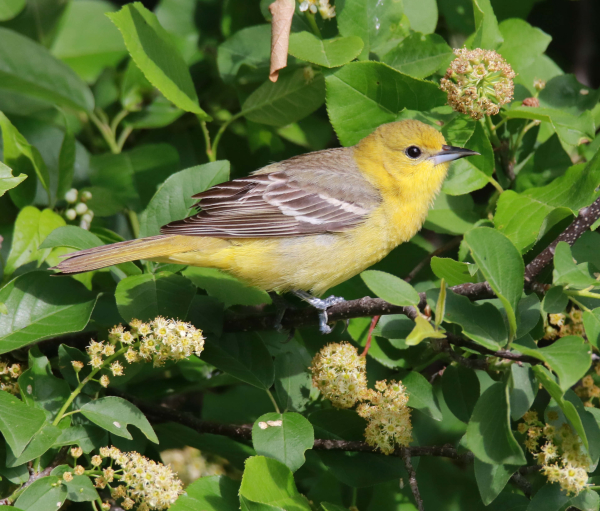
Lately, I’ve been parking my mobile blind at 2 favored photo locations on the edge of the Grove, which are separated by only 40 feet. And that’s where one of the key aspects of the “mobile” comes in. When I want a change of view, or if there is some interesting bird activity at one location or the other, I start my vehicle and cautiously drive slowly ahead, or back up as warranted. So, with little action while parked at the more southern location, when I saw a female Orchard Oriole fly in and begin feeding on some low blooms near my other favored parking site, I decided to make the move forward – hopefully without disturbing the oriole.
This Orchard Oriole behaved quite different from the others, acting quite oblivious to the slow quiet approach of my van, and to its presence when I stopped. The bright yellow oriole turned out to be my best photo subject at the Grove this May, by far! She fed on nectar from abundant fresh yellow blooms, and picked small insects from among the new leaves. All this as I followed her movements through the Tamron zoom lens that has become such a favored and valued photo tool.
Moving slowly upward from branch to branch, starting within a foot of the ground and edging to about eye level – 6 feet high in a chokecherry bush, next to white flower clusters on the edge of the ultra-green Grove. That’s where she made her memorable pause, perching in the open for an extended rest, to my delight.
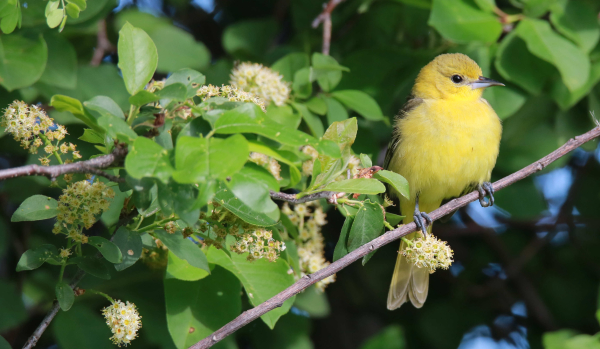
My impression was that this female Orchard Oriole had just completed a leg of her migration north. She was hungry, tired, maybe exhausted, and quenching her thirst and energy needs with fresh flower nectar and tidbits of insect protein. When she paused to perch facing me, I expected it to be a momentary pause; but in retrospect, she found a comfortable spot to rest and perhaps warm in the morning sun. The oriole had now done some feeding, exerted more energy in the process, and now found a quiet place in the sun where she looked this way and that, apparently felt safe, then began a series of short bird naps.
Just having a stationary songbird for a moment or 2 is a delight, but having a beautiful golden oriole providing me with a photo subject that represented all the migrants that passed through the Grove this spring was a thrill. Plus, she provided beautiful images of a female Orchard Oriole in her spring glory among new leaves and blossoms as she reached an important stopover site toward the end of her quest to nest. I was able to zoom my lens in and zoom out, showing different views and angles of the bird, and even to document her nap time with her eyes closed. After her 12 minute rest, she activated again, continued her quest for more flower nectar and bugs, and worked her way higher into the tangle - then into the green curtain of leaves.
As wildlife photographers, we search for these special birds that provide classic photos to illustrate the species itself. I refer to these special birds as “species ambassadors.” They give us much more than a quick snapshot; instead, they share some time with us, in the open, in the sunlight, and act as though we are invisible. They know we are there, but they seem to understand that we are only present to share time and record the moments in photographs; photos we can share with others, even thousands of others if we get images published or or submit photos to FeederWatch or eBird. After all, how many people get to see a female Orchard Oriole with such detail in all her spring glory in the wild?
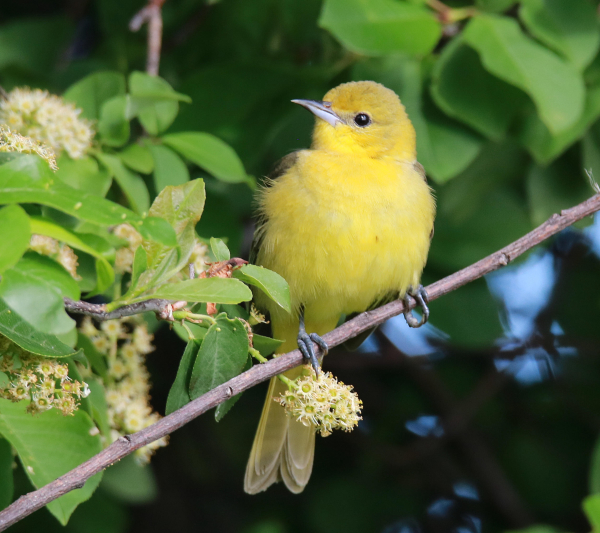
Camera Settings, Super-Zoom, & Lighting
During most of the time I photographed the female oriole, I zoomed the Tamron 150-to-600mm zoom lens to use a 500mm magnification. I was able to do a bit more zooming in and out than usual due to the oriole’s extended time perched motionless in the open. Using the zoom options, I could compose photos with attention to the flower clusters, leaves, and other elements, although I also utilized my photo editing software to crop selected images while reviewing the photos on my computer.
I took the photos using an aperture of f6, which has been my advance setting for all songbird photography at the Grove, and it also provides the narrowest area of focus provided by the Tamron lens. The f6 setting works well for photographing songbirds because it provides an ample area in focus to include the entire bird, but it also blurs out extraneous or unsightly background vegetation. I also used the ISO 400 setting, my standard in sunny lighting conditions.
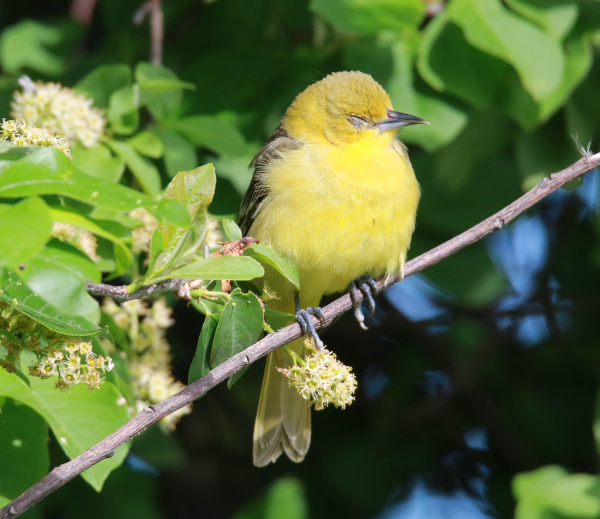
In concert with the aperture setting, I use the Av mode that provides the corresponding shutter speed, which is as fast as possible using the f6 aperture and 400 ISO. For the female oriole photos, the shutter speed varied from 1/640 to 1/400 second, an adequate shutter speed for the low-action photos
When photographing small birds as they move through vegetation, I have been impressed with the acute accuracy of the Tamron lens’s Autofocus in conjunction with my Canon camera’s technology. Time and time again the Autofocus pinpoints my intended location or a bird itself; easy to do in the open, impressive on the edge of thickets. Along with the zoom lens’s Vibration Competition feature, the lens is really providing a best case technical situation for photographing birds – and small songbirds like the Orchard Oriole can be an extreme test for any lens.
As for the lighting, the 10am sunshine was a bit brighter and a little more overhead than I prefer, but realistically there were no shadows to contend with and the morning light provided accurate colors and really sharp features of the oriole’s eyes, bill, and plumage. Of course, I positioned myself on the east side of the Grove with the sun illuminating the eastern edge of trees and bushes. I was indeed positioned between the sun and the bird with the sun at my back and my shadow pointing toward the oriole, as I always profess.
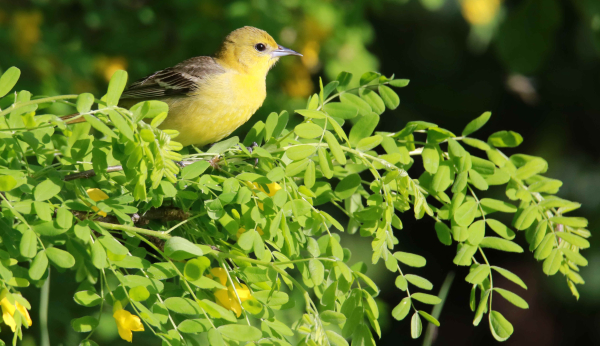
Overall, the technical side of these photos was pretty standard for the conditions and the intended subjects, but it was the trusting Orchard Oriole that provided the life and the spark for the resulting series of photographs. And it’s just that kind of bird that we hope for each time we go birding with our camera. Too often bird photography is a quick reaction to a fleeting moment; how fulfilling it is when we find a bird that acts naturally with a level of trust that benefits our photographic interests. Can’t wait for the next avian ambassador to share some time with; and I hope you have plenty of ambassadorial meetings too.
Article and photographs by Paul Konrad
Share your bird photos and birding experiences at editorstbw2@gmail.com